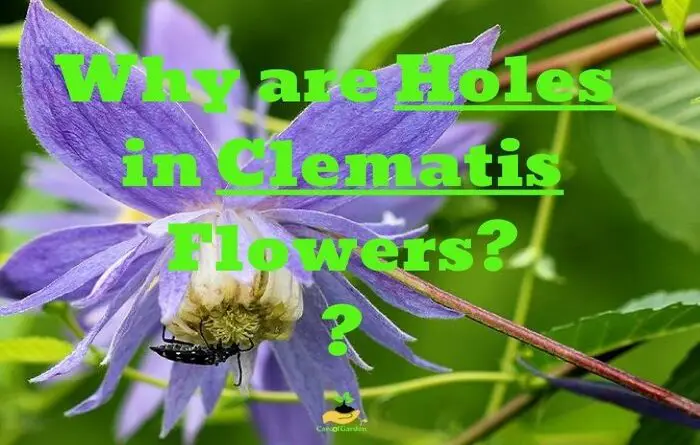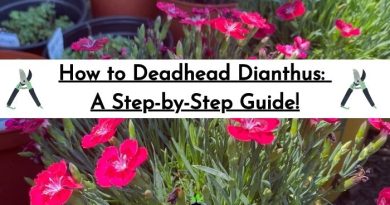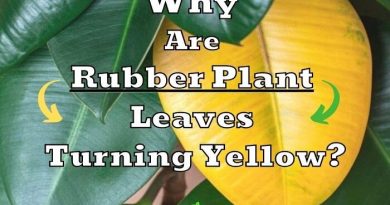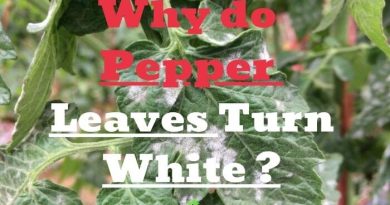Why are Holes in Clematis Flowers? (Easy Answer Here)
Quite popular among gardeners is a plant such as clematis. However, every gardener at least once faced with holes in your clematis flowers. You want to know what causes it?
Among the most common pests that attack the leaves of clematis plants, feeding on them, causing the formation of holes, we find the following: Western flower thrips, Aphids, Earwigs and Snails.
| Why are Holes in Clematis Flowers: |
|---|
| 1. Western flower thrips (Frankliniella occidentalis) |
| 2. Aphids |
| 3. Vine Weevil |
| 4. Earwigs |
| 5. Snails and slugs |
1. California flower thrips
This pest is called western flower thrips (Frankliniella occidentalis) , a fringe-wing species that originally comes from the USA. Damage is caused by their larvae and adults by biting and sucking the cellular content of leaves, which produces white lesions on the epidermis of leaves.
Western flower thrips pierce the clematis flowers from the outside, creating holes. The clematis already looks completely eaten when the flowers open. Some flowers are so badly damaged that they don’t open at all.
The black edges on the flowers and the dark discoloration of the stamens are also very typical. Sometimes the flower also has a reduced number of petals.
Western flower thrips or Californian flower thrips prefer to feed on developing plant tissues such as growing ends and flower buds.
The pest infests Clematis viticella, which has so far been considered extremely robust. Starting in May, puncture marks can be seen on the buds of the clematis.
The beetle then eats inside the bud unnoticed. By the time it blooms, the damage has already happened. The flowers are smaller than usual, stunted and pitted.
So far it is not quite clear how to deal with this pest. The clematis fly bores holes in the flower from around May and eats the bud from the inside out. On the other hand, the clematis fly is also a predatory insect that eats aphids.
The pruning is disposed of in the residual waste. The first blossom does not appear, but the second blossom is usually much less infested.
How to treat California flower thrips
To protect greenhouse plants, biological agents (predatory mites and bedbugs) and glue flower traps are used.
Placement of meshes in the greenhouse bands and check that there are no breaks in the plastic.
Cleaning of weeds inside and outside the greenhouse and elimination of crop residues, especially before making a new plantation, distancing it as long as possible from the previous one.
The biological control method involves introducing beneficial insects to help you eliminate destructive pests. These beneficial insects include green lacewings, tiny pirate bugs, predatory mites, and ladybugs.
If your geranium has holes in their leaves, it might be one of the 3 causes mention in this article.
2. Aphids
Aphids are a clematis problem that can crop up throughout the season. When the clematis is flowering, it is also at its most vulnerable to attack from aphids. These insects suck the sap from the plant, leaving holes in the clematis flowers.
It is difficult to examine clematis for an infestation. Aphids feed on the juices of plants, leaving them with holes and causing them to curl. Ants raid aphid colonies, as they feed on sugary secretions produced by aphids.
You should quickly get an infestation of aphids under control. The aphids themselves are less harmful to the clematis, but they damage the flowers, making it easier for bacteria and fungi to penetrate.
Aphids can be identified by the shiny, sticky coating they leave behind. These insects are especially active in the first half of June, when wings are formed in an adult.
You should watch out for signs such as stunted growth or falling closed buds or yellowing leaves on clematis, as these could be signs of a first infestation. It becomes very clear when the leaves are shiny and sticky with honeydew, because the aphids secrete.
A light infestation can be tolerated, or rather should be tolerated. Ladybugs usually appear within about two weeks, keeping the aphid population in check. In the case of a stronger infestation, spraying with a sharper jet of water or spraying with a soft soap solution often helps.
How to treat holes cause by Aphids
There are a number of simple home remedies you can use to combat it. The easiest method is to spray the plants with a strong jet of water.
Other alternative methods include:
- Spray the clematis with a mixture of 100 g of soft soap and 1 liter of water at intervals of several days;
- Release beneficial insects such as ladybugs or lacewings;
- Plant plants like lavender around the clematis;
3. Vine Weevil
Another common pest of clematis is the vine weevil. These are beetles about one centimeter in size. These nibble on both flowers and leaves of the clematis leaving holes.
The easiest way to recognize him is by his characteristic trunk on his head. The shiny black beetle is also not to be overlooked at approx. 10 mm, but it is nocturnal.
Together with its white larvae, which live in the soil, it causes the following damage:
- Eaten roots
- Disturbed growth, so-called stunted growth
- Holes on the leaves
The vine weevil mainly lays its eggs in the soil of weakened plants and in peaty soil.
Vine Weevil attacks from two positions at once: from above: by insects, from below: by larvae. Such a double attack is very detrimental to the life of the clematis.
In the first case, damage is done to the leaves – the bugs eat them like the Colorado stripes. And bulbs, tubers and rhizomes suffer greatly from the larvae.
When clematis grows near rhododendrons or thuja, the likelihood of infestation with weevils increases. A weakened plant and peaty soil also attract weevils. First and foremost is the weevil.
How to treat clematis holes cause by Vine Weevil
Due to their size and the rather small numbers, vine weevils can be collected by hand. Alternatively, there is also the possibility of working with baited traps. In addition to an attractant, these contain nematodes.
Nematodes allow you to effectively fight this pest, both adult bugs and its caterpillars. Both eat nematodes which will cause them to die from within a few days.
In addition, strengthen your clematis with plant strengtheners and replace peaty soil so that the larvae no longer feel comfortable.
You can also try spraying the plants overnight, when weevils are present, with neem, insecticidal soap, or another insecticidal product. You will certainly need to repeat the treatment: a single spray will not reach them all.
4. Earwigs
These can be quite troublesome, especially if the clematis is near old buildings with cracked bricks or beams, in which the earwigs like to hide during the day.
At night they emerge to eat holes in the clematis leaves, gnaw off young shoots and drill holes in the flower buds, which are often destroyed before opening.
Put moss, hay or straw in a small flower bud and place it upside down on the stick between the plants. The earwigs will crawl into the moss and can be moved or destroyed.
When earwigs scurry through the garden, they only damage the plants if they occur in large numbers. In some cases, the insects are among the beneficial insects that hunt aphids and other real pests.
To get rid of earwigs in the garden, fill an old flower pot with wood shavings or straw and hang it upside down. Once the little animals have gathered in it, they can easily be relocated.
5. Snails and slugs
Slugs and snails are among the biggest predators of clematis, eating the leaves and stems of clematis at night. During the day, they hide from the sun under fallen dry leaves and stones. So it is advisable to always keep the ground under clematis clean.
Snails and slugs become more active in wet weather. Several varieties of snails and slugs begin their destructive activity of eating clematis shoots starting in spring, when the weather is warm.
Pests such as snails and slugs can appear on clematis at any time during the year. Snails and slugs destroy the central buds on the clematis shoots, which stops the growth of the bush and usually becomes a gateway for infections.
The favorite habitat of slugs is large leaves of weeds. The soil under clematis should be kept clean and loose. To stop an invasion, you can spray the surface with ash, superphosphate, or lime. This will scare away snails and slugs, but will not help stop an invasion that has already begun.
In order to prevent damage by slugs, it is necessary to keep the ground around the bushes in a clean, necessarily loose state – these pests usually live on large leaves of weeds.
How to treat holes cause by Snail and Slugs
There are various ways to get rid of slugs and snails, all of which can be used at the same time to solve the problem safely and quickly. In principle, the causes of snail infestation should also be counteracted.
As a preventive measure, sprinkling the earth with ash, salt or lime is used. However, these measures can scare away the slugs. If the invasion has already begun, it will no longer be possible to stop it in this way.
You can fight them by regularly loosening the soil under the plants, setting traps and collecting them by hand.
To save your clematis, you must fight the slugs as soon as you spot them. During the day, the slugs usually hide near the plants. Find them and collect them. You can also search after sunset armed with a flashlight.
If the population of snails has gotten out of hand, you may have to fight them with other means. For example with nematodes, slug pellets or a slug fence around the clematis.
How To Prevent Holes in Clematis Flowers
- Plant clematis in well-drained soil.
- When planting, bury the stems 15 cm.
- Remove diseased stems quickly, being careful not to injure other stems when pruning. If the entire stem is affected, prune it below the ground. Disinfect the shears between each cut.
- Give your plant good basic maintenance (watering in times of drought, occasional fertilization, etc.).
- Do not water the foliage.
- Avoid weeding at the base of the plant.
- Cover the soil with thick mulch.
- Water once every fortnight with horsetail manure.
How To Keep Clematis Flowers Healthy
- Location : these plants are distributed in almost all regions of the planet, so they can grow in both temperate and tropical climates. What they do not support is high temperatures.
- Light : one of the factors to take into account when planting one of these species is light. Ideally, the roots should be kept in a shady area and the stems should receive a good amount of sunlight.
- Soil : they are not demanding in terms of the type of soil, being able to live in limestone soils poor in nutrients and poorly drained.
- Irrigation : Clematis are capable of surviving droughts, even so it is advisable to water it a couple of times a week. Depending on the ambient humidity, pour one amount of water or another.
- Fertilizer : to achieve a healthy and vigorous plantation, it is best to fertilize from spring to autumn. Use an organic fertilizer such as guano, algae extract and even compost .
- Transplant : they must be transplanted every so often. The ideal is to do it in spring, which is the period in which the frosts have already passed.
- Pruning : Clematis grow at a good rate, therefore, it is often necessary to prune them. Do it whenever the plant requires it, that is, when it has grown excessively. Don’t prune in winter.
Conclusion
There are many pests who want to feast on clematis flowers causing holes in them. But it should be remembered that a strong plant with a good immune system is able to protect itself, but do not forget to periodically inspect the plants in order to notice bad symptoms in time and have time to take action.




